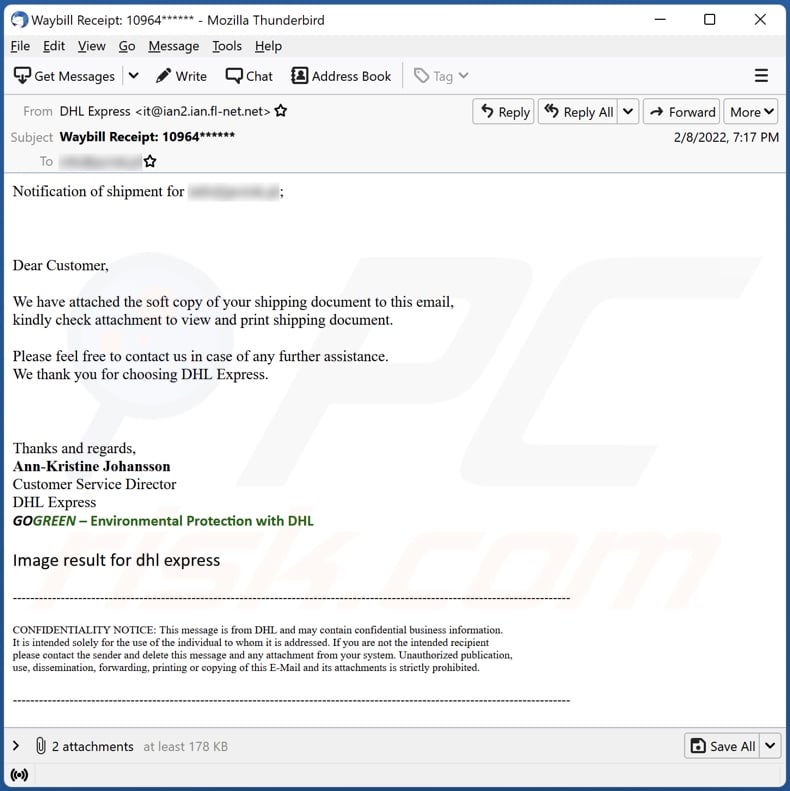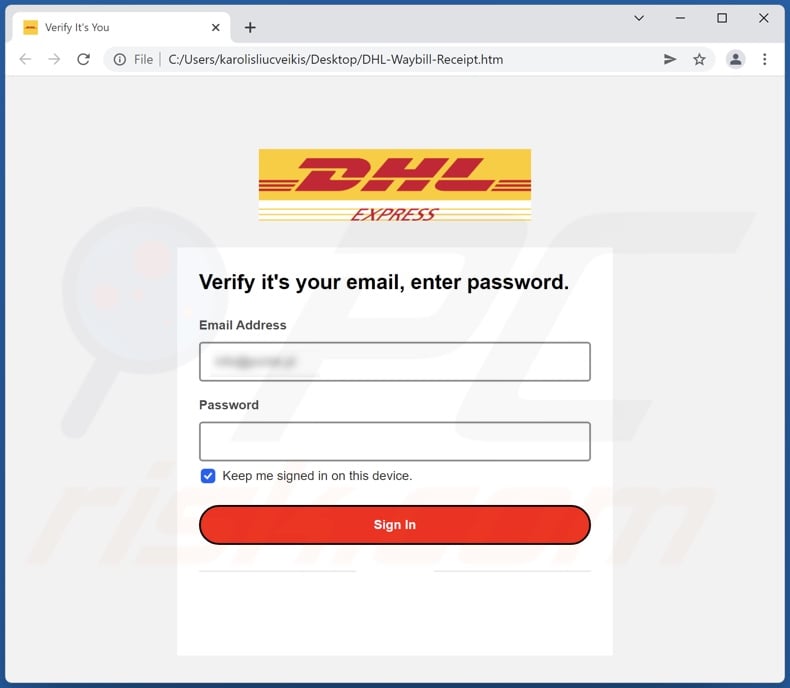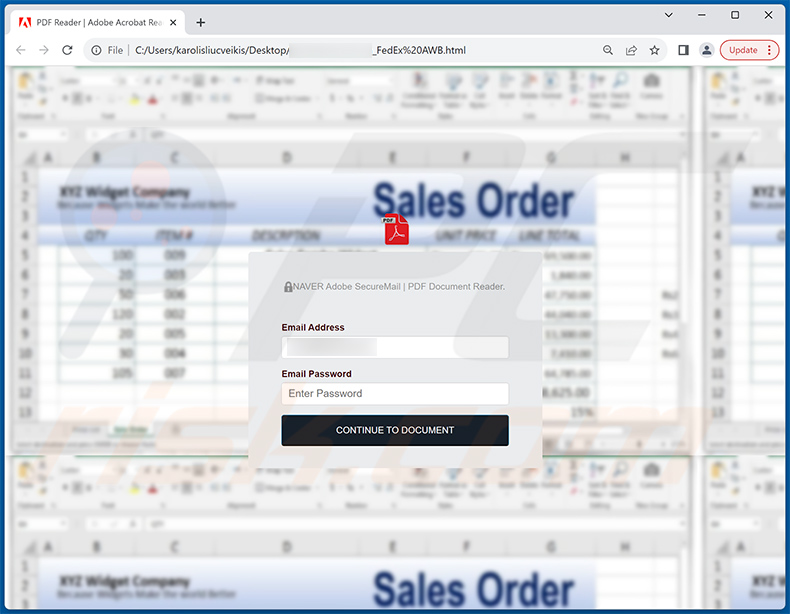Avoid having your email stolen via Notification Of DHL Shipment phishing emails
Phishing/ScamAlso Known As: Notification Of DHL Shipment phishing email
Get free scan and check if your device is infected.
Remove it nowTo use full-featured product, you have to purchase a license for Combo Cleaner. Seven days free trial available. Combo Cleaner is owned and operated by RCS LT, the parent company of PCRisk.com.
What is the "Notification Of DHL Shipment" email?
Our researchers determined that "Notification Of DHL Shipment" is a spam email. It is not associated with DHL - the logistics and delivery company; cyber criminals merely use the name to trick recipients into falling for the phishing scam. This fake notification targets email account log-in credentials through a phishing file attached to it.

"Notification Of DHL Shipment" email scam overview
The spam email with the subject "Waybill Receipt: [number]" requests recipients to review and print the shipping document attachment.
Instead of containing said information, the attached HTML file requires verification via users' email accounts. The passwords typed into this phishing document are disclosed to the scammers behind the spam campaign. With this information in their possession, cyber criminals can steal the exposed email accounts and the content connected (e.g., registered) through them.
To elaborate, the criminals can use communication platforms (e.g., emails, social networking, messengers, etc.) to ask contacts/friends for loans. Additionally, they can be employed to proliferate malware by sharing malicious files/links. Online banking, e-commerce, and other finance-related accounts can be used to make fraudulent transactions and online purchases.
In summary, by trusting the "Notification Of DHL Shipment" scam emails, users can experience severe privacy issues, financial losses, and even identity theft.
| Name | Notification Of DHL Shipment phishing email |
| Threat Type | Phishing, Scam, Social Engineering, Fraud |
| Fake Claim | Email contains a shipping document that has to be reviewed and printed. |
| Disguise | Notifications from DHL. |
| Attachment(s) | DHL-Waybill-Receipt.htm (filename may vary) |
| Detection Names (phishing attachment) | Avast (HTML:Phishing-BVB [Phish]), Combo Cleaner (Trojan.Agent.FPUA), ESET-NOD32 (HTML/Phishing.Gen), Kaspersky (Trojan.HTML.Agent.sg), Tencent (Win32.Trojan.Agent.Akfb), Full List Of Detections (VirusTotal) |
| Symptoms | Unauthorized online purchases, changed online account passwords, identity theft, illegal access of the computer. |
| Distribution methods | Deceptive emails, rogue online pop-up ads, search engine poisoning techniques, misspelled domains. |
| Damage | Loss of sensitive private information, monetary loss, identity theft. |
| Malware Removal (Windows) |
To eliminate possible malware infections, scan your computer with legitimate antivirus software. Our security researchers recommend using Combo Cleaner. Download Combo CleanerTo use full-featured product, you have to purchase a license for Combo Cleaner. 7 days free trial available. Combo Cleaner is owned and operated by RCS LT, the parent company of PCRisk.com. |
Phishing email examples
We have analyzed thousands of spam emails; "Important Update From Mail Server Registrar", "You have sent the payment - PayPal", "Closing Of Email Address Notice !", and "MojeBanka email scam" are just a few examples of those used for phishing.
Furthermore, spam mail is also employed to distribute malware (e.g., trojans, ransomware, etc.). These emails are usually presented as "important", "urgent", and similar; they are often disguised as messages from genuine institutions, authorities, companies, service providers, and other large entities as well.
How do spam campaigns infect computers?
Spam emails can have malicious files as attachments or download links. These files can be Microsoft Office and PDF documents, archives, executables, JavaScript. When the files are executed, run, or otherwise opened - the infection chain is initiated.
For example, when opened in Microsoft Office versions released before 2010 - the MS documents execute malicious macro commands and begin the infection process. Later versions have "Protected View" mode; hence, users have to manually enable macros (i.e., editing/content). It is noteworthy that most infectious documents contain messages designed to lure users into enabling macro commands.
How to avoid installation of malware?
We advise exercising caution with incoming emails and messages. The attachments and links found in suspicious/irrelevant mail - must not be opened, as that can result in a system infection. Additionally, it is recommended to use Microsoft Office versions released after 2010.
Aside from spam mail, malware is also spread through dubious download channels (e.g., unofficial and freeware sites, Peer-to-Peer sharing networks, etc.), illegal activation tools ("cracks"), and fake updates. Therefore, it is crucial to download only from official/verified sources and activate/update software with tools provided by legitimate developers.
We must emphasize the importance of having an anti-virus installed and updated. Security programs must be used to perform regular system scans and to remove detected threats. If you've already opened malicious attachments, we recommend running a scan with Combo Cleaner Antivirus for Windows to automatically eliminate infiltrated malware.
Text presented in the "Notification Of DHL Shipment" email letter:
Subject: Waybill Receipt: 10964******
Notification of shipment for -;
Dear Customer,
We have attached the soft copy of your shipping document to this email,
kindly check attachment to view and print shipping document.
Please feel free to contact us in case of any further assistance.
We thank you for choosing DHL Express.
Thanks and regards,
Ann-Kristine Johansson
Customer Service Director
DHL Express
GOGREEN – Environmental Protection with DHL
Image result for dhl express
------------------------------------------------------
CONFIDENTIALITY NOTICE: This message is from DHL and may contain confidential business information.
It is intended solely for the use of the individual to whom it is addressed. If you are not the intended recipient
please contact the sender and delete this message and any attachment from your system. Unauthorized publication,
use, dissemination, forwarding, printing or copying of this E-Mail and its attachments is strictly prohibited.
------------------------------------------------------
Screenshot of the phishing attachment distributed via "Notification Of DHL Shipment" spam campaign ("DHL-Waybill-Receipt.htm"):

Screenshot of a phishing HTML document distributed via another variant of "Notification Of DHL Shipment" spam email:

Instant automatic malware removal:
Manual threat removal might be a lengthy and complicated process that requires advanced IT skills. Combo Cleaner is a professional automatic malware removal tool that is recommended to get rid of malware. Download it by clicking the button below:
DOWNLOAD Combo CleanerBy downloading any software listed on this website you agree to our Privacy Policy and Terms of Use. To use full-featured product, you have to purchase a license for Combo Cleaner. 7 days free trial available. Combo Cleaner is owned and operated by RCS LT, the parent company of PCRisk.com.
Quick menu:
- What is Notification Of DHL Shipment phishing email?
- Types of malicious emails.
- How to spot a malicious email?
- What to do if you fell for an email scam?
Types of malicious emails:
![]() Phishing Emails
Phishing Emails
Most commonly, cybercriminals use deceptive emails to trick Internet users into giving away their sensitive private information, for example, login information for various online services, email accounts, or online banking information.
Such attacks are called phishing. In a phishing attack, cybercriminals usually send an email message with some popular service logo (for example, Microsoft, DHL, Amazon, Netflix), create urgency (wrong shipping address, expired password, etc.), and place a link which they hope their potential victims will click on.
After clicking the link presented in such email message, victims are redirected to a fake website that looks identical or extremely similar to the original one. Victims are then asked to enter their password, credit card details, or some other information that gets stolen by cybercriminals.
![]() Emails with Malicious Attachments
Emails with Malicious Attachments
Another popular attack vector is email spam with malicious attachments that infect users' computers with malware. Malicious attachments usually carry trojans that are capable of stealing passwords, banking information, and other sensitive information.
In such attacks, cybercriminals' main goal is to trick their potential victims into opening an infected email attachment. To achieve this goal, email messages usually talk about recently received invoices, faxes, or voice messages.
If a potential victim falls for the lure and opens the attachment, their computers get infected, and cybercriminals can collect a lot of sensitive information.
While it's a more complicated method to steal personal information (spam filters and antivirus programs usually detect such attempts), if successful, cybercriminals can get a much wider array of data and can collect information for a long period of time.
![]() Sextortion Emails
Sextortion Emails
This is a type of phishing. In this case, users receive an email claiming that a cybercriminal could access the webcam of the potential victim and has a video recording of one's masturbation.
To get rid of the video, victims are asked to pay a ransom (usually using Bitcoin or another cryptocurrency). Nevertheless, all of these claims are false - users who receive such emails should ignore and delete them.
How to spot a malicious email?
While cyber criminals try to make their lure emails look trustworthy, here are some things that you should look for when trying to spot a phishing email:
- Check the sender's ("from") email address: Hover your mouse over the "from" address and check if it's legitimate. For example, if you received an email from Microsoft, be sure to check if the email address is @microsoft.com and not something suspicious like @m1crosoft.com, @microsfot.com, @account-security-noreply.com, etc.
- Check for generic greetings: If the greeting in the email is "Dear user", "Dear @youremail.com", "Dear valued customer", this should raise suspiciousness. Most commonly, companies call you by your name. Lack of this information could signal a phishing attempt.
- Check the links in the email: Hover your mouse over the link presented in the email, if the link that appears seems suspicious, don't click it. For example, if you received an email from Microsoft and the link in the email shows that it will go to firebasestorage.googleapis.com/v0... you shouldn't trust it. It's best not to click any links in the emails but to visit the company website that sent you the email in the first place.
- Don't blindly trust email attachments: Most commonly, legitimate companies will ask you to log in to their website and to view any documents there; if you received an email with an attachment, it's a good idea to scan it with an antivirus application. Infected email attachments are a common attack vector used by cybercriminals.
To minimise the risk of opening phishing and malicious emails we recommend using Combo Cleaner Antivirus for Windows.
Example of a spam email:

What to do if you fell for an email scam?
- If you clicked on a link in a phishing email and entered your password - be sure to change your password as soon as possible. Usually, cybercriminals collect stolen credentials and then sell them to other groups that use them for malicious purposes. If you change your password in a timely manner, there's a chance that criminals won't have enough time to do any damage.
- If you entered your credit card information - contact your bank as soon as possible and explain the situation. There's a good chance that you will need to cancel your compromised credit card and get a new one.
- If you see any signs of identity theft - you should immediately contact the Federal Trade Commission. This institution will collect information about your situation and create a personal recovery plan.
- If you opened a malicious attachment - your computer is probably infected, you should scan it with a reputable antivirus application. For this purpose, we recommend using Combo Cleaner Antivirus for Windows.
- Help other Internet users - report phishing emails to Anti-Phishing Working Group, FBI’s Internet Crime Complaint Center, National Fraud Information Center and U.S. Department of Justice.
Frequently Asked Questions (FAQ)
Why did I receive this email?
Spam emails are sent in large-scale operations. Hence, thousands of users receive the same email letters.
I have provided my personal information when tricked by this spam email, what should I do?
If you have provided account credentials - change the passwords of all potentially compromised accounts and inform their official support. And if you have disclosed other personal information (e.g., ID card details, credit card numbers, etc.) - contact the corresponding authorities without delay
I have read a spam email but didn't open the attachment, is my computer infected?
No, merely reading a spam email will not initiate any infection processes. Malware download/installation chains are jumpstarted when the attachments are opened or links are clicked.
I have downloaded and opened a file attached to a spam email, is my computer infected?
Whether an infection was triggered - depends on the opened file's format. Executables (.exe, .run, etc.) install malware upon being opened almost without fail. However, document formats (.doc, .xls, .pdf, etc.) may require additional interaction (e.g., enabling macro commands) - to start infection processes. In case of the "Notification Of DHL Shipment" spam emails, they have a phishing HTML file attached to them. Instead of malware download/installation, these files are designed to extract users' log-in credentials.
Will Combo Cleaner remove malware infections present in email attachments?
Yes, Combo Cleaner can detect and eliminate nearly all known malware infections. However, performing a complete system scan is crucial - since sophisticated malicious software typically hides deep within the system.
Share:

Tomas Meskauskas
Expert security researcher, professional malware analyst
I am passionate about computer security and technology. I have an experience of over 10 years working in various companies related to computer technical issue solving and Internet security. I have been working as an author and editor for pcrisk.com since 2010. Follow me on Twitter and LinkedIn to stay informed about the latest online security threats.
PCrisk security portal is brought by a company RCS LT.
Joined forces of security researchers help educate computer users about the latest online security threats. More information about the company RCS LT.
Our malware removal guides are free. However, if you want to support us you can send us a donation.
DonatePCrisk security portal is brought by a company RCS LT.
Joined forces of security researchers help educate computer users about the latest online security threats. More information about the company RCS LT.
Our malware removal guides are free. However, if you want to support us you can send us a donation.
Donate
▼ Show Discussion